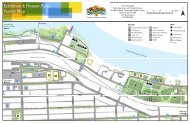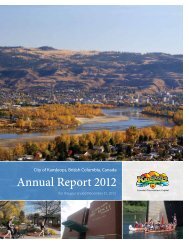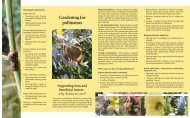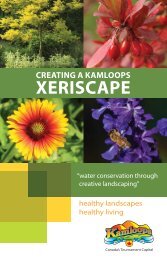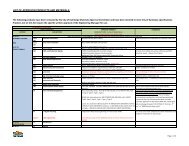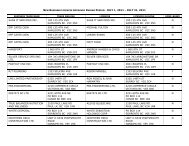Planting the seeds for a sustainable future - City of Kamloops
Planting the seeds for a sustainable future - City of Kamloops
Planting the seeds for a sustainable future - City of Kamloops
You also want an ePaper? Increase the reach of your titles
YUMPU automatically turns print PDFs into web optimized ePapers that Google loves.
Ranchers in <strong>Kamloops</strong> depend on Crown rangeland. Crown range is typically usedfrom May to October with private lands supplying <strong>the</strong> <strong>for</strong>age requirements <strong>for</strong> <strong>the</strong>remainder <strong>of</strong> <strong>the</strong> year.Rangeland is <strong>of</strong>ten damaged by unmanaged activities. Plants are typically injuredor killed by severe trampling; overuse by both wildlife and livestock; andunauthorized use by all-terrain vehicles, pedal bikes, and <strong>of</strong>f-road vehicles. Theresulting damage severely limits <strong>the</strong> range from per<strong>for</strong>ming important ecologicalfunctions such as holding <strong>the</strong> soil and water in place. Human disturbance alsoprovides an ideal site <strong>for</strong> weed invasion. Weeds such as toadflax, leafy spurge,knapweed, houndstongue, orange-flowered hawkweed, and Canada thistle are alla serious menace to <strong>the</strong> health <strong>of</strong> BC rangelands.With good range management, cattle grazing is compatible with many <strong>of</strong> <strong>the</strong>seo<strong>the</strong>r uses and, in some cases, can improve <strong>the</strong> range <strong>for</strong> o<strong>the</strong>r uses. Wildlifepredation on cattle can create significant economic impact on ranchers. O<strong>the</strong>rchallenges facing ranchers are mostly related to <strong>the</strong> costs <strong>of</strong> inputs and <strong>the</strong> effect<strong>of</strong> issues such as international trade, <strong>the</strong> relative value <strong>of</strong> <strong>the</strong> Canadian dollar, and<strong>the</strong> demand <strong>for</strong> beef, all <strong>of</strong> which affect <strong>the</strong> prices <strong>the</strong>y receive <strong>for</strong> <strong>the</strong>ir animals.Ranching fits nicely with <strong>the</strong> land base, topography and climate in <strong>the</strong> <strong>Kamloops</strong>area. Consumers have become accustomed to grain-fed beef, meaning beef thathas been raised eating grass and finished on grain. BC ranchers can viablyproduce calves and raise <strong>the</strong>m to a certain weight on grass <strong>for</strong>age. After that,<strong>the</strong>y need a mix <strong>of</strong> grain and <strong>for</strong>age or o<strong>the</strong>r roughage. For <strong>the</strong> finishing process, cows are sent to Alberta, to large feedlots,which tend to have access to cheaper feed grain. There is growing evidence that grass-fed beef contains higher levels <strong>of</strong>conjugated linoleic acids that may have apparent health benefits. This is an opportunity on which some ranchers in <strong>the</strong>Sou<strong>the</strong>rn Interior have begun to capitalize.Ranching extends far beyond <strong>the</strong> political boundaries <strong>for</strong> <strong>the</strong> <strong>City</strong> <strong>of</strong> <strong>Kamloops</strong> indicatingland interdependence between <strong>the</strong> <strong>City</strong> <strong>of</strong> <strong>Kamloops</strong> and <strong>the</strong> extensive agricultural landbase within <strong>the</strong> TNRD.Dairy farms can operate in <strong>the</strong><strong>Kamloops</strong> area, Blackwell Dairybeing a case in point. There aresome dairy farms relocating to <strong>the</strong>Thompson Nicola area. Some <strong>of</strong><strong>the</strong>se are moving all operationsbut o<strong>the</strong>rs are starting up branchfarms to raise replacement cows.Silage corn grows very well in <strong>the</strong><strong>Kamloops</strong> area but few beefproducers grow corn due to <strong>the</strong>specialized inputs required. Cornis <strong>of</strong>ten used to feed cows, so ifdairy operations increase in <strong>the</strong>region, corn production will likelyfollow suit.CITY OF KAMLOOPS 20




